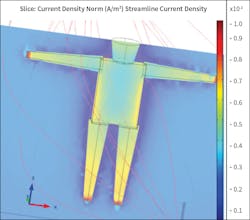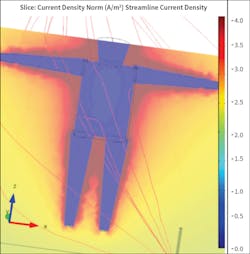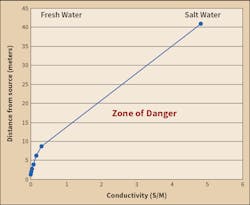The Science Behind Electric Shock Drowning
Electric shock drowning (ESD) is a regular topic in the press, in boating magazines, on various electrical industry websites, and in ECM magazine. ESD occurs when a swimmer enters an area where there is electrical current flow in the water, and that current flow causes uncontrollable muscle contraction, which leads to drowning. BoatUS reports that at least 30 ESD deaths occurred between 1999 and 2010; others suggest that number is even higher.
No one questions that water combined with electricity is a dangerous mixture. There is no doubt ESD exists — and that actions must be taken to create safer environments when water and electricity share the same space, such as those found in marinas, swimming pools, and water features. Technology like GFCIs, low-voltage lighting systems, and shipboard isolation transformers have gone a long way toward creating safer electrical environments in areas when water is present, but there’s still work to do.
What We Know
Dr. Morse has personally evaluated several cases in which individuals in fresh, salt, and chlorinated water have died as a result of electrical current flow in the water, presumably from either electrically induced ventricular fibrillation or electrically induced muscle paralysis that causes ESD.
The science behind ESD is simple. A current source, such as an energized broken wire touching a body of water, allows current to flow in the water. The current then seeks its way through the water to ground. A swimmer in the water passes through the flow of current and becomes part of the invisible circuit between source and ground. The current flow through the swimmer causes a level of muscle contraction that he or she cannot control or override, leading to electrically induced paralysis and resultant drowning. ESD is different from electrically induced ventricular fibrillation, which requires a much greater current. In electrically initiated ventricular fibrillation, the current flow must traverse the heart muscle.
Over the years, many have observed that ESD seems to be most prevalent in freshwater environments, concluding that this is because the conductivity of the human body is higher than that of the surrounding fresh water (leading to current flow along the path of least resistance, being through the body of the swimmer). The most accurate statement is not that “current follows the path of least resistance” but rather that current follows all paths in inverse proportion to the resistance of the path. This would imply that the geometry of the environment and the location of source and ground would play a significant role in path resistance. Physics tells us that the current will not divert in great proportion to a more conductive human body if the overall path to ground is longer, representing greater resistance than other paths.
Quest to Know More
While the theory of ESD makes absolute sense — and is certainly supported by the existence of numerous documented ESD deaths — both authors could find no scientific literature that analyzes and quantifies the theory considering the laws of physics and the geometry of the electrical environment. As such, they set out using modern computer simulation software to study and provide scientific support and basis for ESD.
The human body has natural resistance to current flow through the skin that is almost completely defeated in the presence of water. It also takes very little current, less than 16mA (hand-to-hand), in almost 100% of the population to cause what is known as tetanic muscle contraction — where all muscle fibers along the path of the current are stimulated to maximal contraction. This is compared to a minimum current of 50mA needed to cause ventricular fibrillation in a small percentage of the population.
Absent water, electrically induced tetanic contraction is painful, but has little or no lasting effect after the current is shut off. In the presence of water, electrically induced tetanic contraction is a lethal recipe that will cause immediate and uncontrollable muscle contraction, leading to drowning with no hope of self-rescue.
To provide the scientific basis for ESD, the authors decided to use a technique known as finite element analysis (FEA). Using FEA, a complex physical environment (such as a swimmer in a body of electrified water) can be broken down into a solvable mathematical problem that will predict where and how much current flows in the swimmer and how much will flow through and around the swimmer. FEA breaks the physically complex world into many small physically simple geometric elements with known uniform characteristics. A complex and varied three-dimensional space can be broken down into a puzzle consisting of hundreds of thousands of physically simple cubes or tetrahedrons, each of which is responsive to the inputs from its neighbors and provides output to its neighbors. Solving current flow through any individual element involves solving all the equations involving all neighboring elements.
As complex as this sounds (and it is), the issue is more about processing time and power than mathematical complexity. Given known parameters (such as conductivity measured in Siemens/meter) for each element — and given enough elements — an accurate solution to the current flow problem can be derived and represented graphically. The final solution takes source and ground information, feeds it into a body of water containing a swimmer, and can tell current flow (or current density) at any element in the model.
Research Results
For the analysis, the authors created a three-dimensional environment with current introduced into a body of water by a wire presumed to have fallen into the water, energized to 120V. The pathway to ground was provided by a remote piece of metal (like part of a dock or boat) connected back to earth ground. The swimmer was created to have the profile of an individual bobbing in the water with the conductivity characteristics of skeletal muscle (0.355 S/m) where current would likely flow in greatest density. Numerous simulations were run, varying the position of the swimmer relative to source and ground and the conductivity of the water from relatively pure lake or drinking water (0.005 S/m to 0.04 S/m) to brackish water (0.08 S/m to 2.56 S/m) to salt water (4.8 S/m).
The simulations yielded some interesting results. Figure 1 and Fig. 2 show the results for current density in and near the swimmer at opposite ends of the conductivity spectrum of fresh to salt water. In both simulations, the swimmer is centered on the shortest line between source and ground, placing the swimmer in the shortest physical path from source to ground. From the figures, two things become immediately obvious. The first is that in fresh water, the current density is higher in the higher conductivity body of the swimmer than in the surrounding water. The second is that in salt water, current shunts around the swimmer in the higher conductivity salt water. These simulations demonstrate that the theory of ESD is based on sound science.
It’s important to note that the scale (representing Amperes per square meter) on the side of the two figures is off by two orders of magnitude between fresh and saltwater simulation. The reason for this is that fresh water is not only more resistive than the swimmer, but it also creates significantly more resistance along the pathway from source to ground. In fresh water, current flow is limited as the result of the limiting ability of water (without ions) to conduct electricity. Conversely, in salt water, current will flow at a much higher level for much greater distances because salt water is very conductive.
The simulations tell us that the theory of current shunting as a part of ESD is true, but because of the resistance posed by fresh water, ESD can only occur when source and ground are relatively close to each other in a freshwater environment.
The authors decided to quantify what they have defined as a “Zone of Danger,” being the distance at which total body current exceeds 20mA as a function of water conductivity. This is shown in Fig. 3. The Zone of Danger (as defined here) is merely useful for comparison for defining risk of ESD as a function of water conductivity, placement of the swimmer, source, and ground.
The authors note that these simulations demonstrate what Dr. Morse has seen experientially through consultation, which is that ESD drowning can occur in both fresh and salt water as well as in pool water (where conductivity is typically
2.5 S/m to 3.0 S/m).
Final Thoughts
Why then is ESD noted to occur with such frequency in fresh water? The answer may have to do with the number of freshwater docks or the level of maintenance as a generality when comparing salt and freshwater marinas. It may also be linked to the idea that marina owners in saltwater environments are more fearful of the risk associated with electricity contacting the salt water. These thoughts are at best speculative and need to be explored before any firm conclusions can be drawn.
The authors recognize that education and developing a practical approach to identifying energized water and to self-rescue in any ESD-type situation may have value. The authors are not prepared to make recommendations, but think that experts in ESD should come together to teach swimmers how best to respond when in electrified water. Swimmers should be warned as to how to identify what the first signs of electrified water would be. Muscle tingling followed by annoying but controllable muscle contraction would precede uncontrollable tetanic contraction as one moves further into the Zone of Danger. The natural human response to the uncomfortable feeling of being in electrified water is likely to swim toward the nearest dock, which may well also be to swim further into the Zone of Danger. It should be considered if it would be best to teach swimmers to go in a direction known to be less electrified and to change one’s profile to reduce total body current exposure and thus reduce muscle contraction.
The authors also suggest that marinas and boat owners be educated as to how to test for, identify, and reduce risks that will energize the water. The use of isolation transformers on boats and the use of GFCIs on both dock outlets and shore power outlets would dramatically reduce instances of current flow into the water. (Note: In the author’s experience, the use of GFCIs on shore power outlets is often rejected because of the false trips, which then shut off power to a boat’s battery charger and reduce the effectiveness of operating bilge pumps as batteries deplete without the operating charger.)
Although the authors do not disagree that it would prevent ESD drownings if people did not swim off docks, it is highly unlikely that risk of ESD would dissuade people from jumping into the water on a hot day. Perhaps it would be better to use sensors that can easily monitor for current in the water near docks.
Author’s Note: The authors would like to thank undergraduate students Jesse Kotsch and Brandon Prussak for their participation in the simulations.
Dr. Morse and Dr. Kohl are professors at the University of San Diego. Dr. Morse has reviewed hundreds of electrical injury cases and has been researching electric shock drowning with Dr. Kohl for the past two years. More information can be found at http://www.electricalinjury.com.



